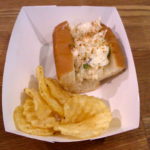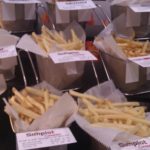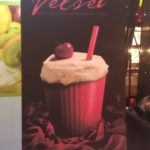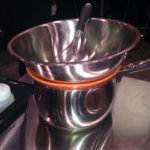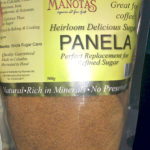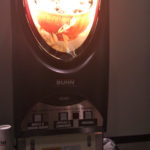Summer Session 1: Gastronomy Courses Spotlight
As the spring semester comes to a close, we know you're already chomping at the bit for summer classes. Summer 1 kicks off May 21 and concludes June 28.
The following fabulous courses still have space:
ARCHAEOLOGY OF FOOD IN ANCIENT TIMES (MET ML 611)
 Course Summary: Beginning with early humans up to early farmers, the course explores food used by hunter/gatherers and changes in diet and nutrition through time. Examines archaeological evidence for types of plants and animals exploited for food, as well as human skeletal evidence for ancient nutrition and diseases related to diet and food stress. Consideration of early historical periods, especially in terms of how certain foods such as wine have played a significant role in culture beyond basic dietary needs.
Course Summary: Beginning with early humans up to early farmers, the course explores food used by hunter/gatherers and changes in diet and nutrition through time. Examines archaeological evidence for types of plants and animals exploited for food, as well as human skeletal evidence for ancient nutrition and diseases related to diet and food stress. Consideration of early historical periods, especially in terms of how certain foods such as wine have played a significant role in culture beyond basic dietary needs.
Bonuses: The course includes a trip to Plimoth Plantation with a self-guided tour, a visit with the curator of collections and the Plimoth food historian, and lunch with options like succotash, stuffed quahog, peas cod, salmon burgers, and Indian pudding.
Instructor: Karen Metheny
Class Meets: Tuesday/Thursday, 5:30-9:00 pm
ART AND FOOD (MET ML 672)
 Course Summary: Focusing on the dialogue between gastronomy and art, from antiquity to the present, this seminar offers students the opportunity to research the work of artists who represented food, drink, harvest, and hunger; the role of the decorative arts in dining; and the relationship of national traditions of art and cuisine. Providing an introduction to fundamental aspects of the art historical periods in question, the course is designed to accommodate students without previous formal study of either art history or gastronomy.
Course Summary: Focusing on the dialogue between gastronomy and art, from antiquity to the present, this seminar offers students the opportunity to research the work of artists who represented food, drink, harvest, and hunger; the role of the decorative arts in dining; and the relationship of national traditions of art and cuisine. Providing an introduction to fundamental aspects of the art historical periods in question, the course is designed to accommodate students without previous formal study of either art history or gastronomy.
Bonuses: Course includes cooking demonstrations and visits to the Boston Museum of Fine Arts.
Instructor: Jonathan Ribner
Class Meets: Monday/Wednesday, 5:30-9:00 pm
CULTURE & CUISINE: ETHNIC FOODWAYS IN THE UNITED STATES (MET ML 631)
 Summary: What is ethnicity? Is all American food also ethnic food? This course will explore the creation, exchange, and consumption of ethnic foodways in the United States. In particular, we will look at food as a cultural artifact that is intrinsically tied to individual and group identity. We will study what Americans eat, and how that food is intertwined with ideas about identity and the United States as a nation. This interdisciplinary study of food and culture will look at the evolution of ethnic food in the United States, and will cover a range of topics from immigrant adaptations of cuisines, culinary tourism and the ever popular, quest for “authentic” cuisine. The intent is to think critically about ethnic food and to draw conclusions about American behaviors, tastes, and identity.
Summary: What is ethnicity? Is all American food also ethnic food? This course will explore the creation, exchange, and consumption of ethnic foodways in the United States. In particular, we will look at food as a cultural artifact that is intrinsically tied to individual and group identity. We will study what Americans eat, and how that food is intertwined with ideas about identity and the United States as a nation. This interdisciplinary study of food and culture will look at the evolution of ethnic food in the United States, and will cover a range of topics from immigrant adaptations of cuisines, culinary tourism and the ever popular, quest for “authentic” cuisine. The intent is to think critically about ethnic food and to draw conclusions about American behaviors, tastes, and identity.
Bonuses: Course includes a field trip, guest speakers including chefs and restaurant owners, and the opportunity to practice oral histories and analysis of primary sources, such as old cookbooks, menus, and advertisements.
Instructor: Amanda Mayo
Class Meets: Tuesday/Thursday, 5:30-9:00 pm
Save the Date: End of the Semester/Graduation Celebration
 As some of us stress to finish our papers and study for final exams, others of us are counting down the days to life after Gastronomy.
As some of us stress to finish our papers and study for final exams, others of us are counting down the days to life after Gastronomy.
Please join us to celebrate both the end of the semester and the largest graduating class (thus far!) from the Boston University Gastronomy program.
Who: Current and graduating Gastronomy students, alumni, and faculty
When: Friday, May 11, 6:00-8:00 pm
Where: 808 Commonwealth Ave, Demonstration Room (117)
What: Cake and drinks
Feel free to bring a potluck appetizer, but don't worry, this is optional. Bringing yourself is most important.
Now Available: BU Gastronomy Tote Bags and Aprons
The results are in - you’ve voted “Think Good Food” as the winning design for your BU Gastronomy swag! Thanks to all who submitted an entry and participated in the poll. The winning design was created by Gastronomy student and graduate assistant, Lucia Austria.
You can purchase your tote bag through our own BU Gastronomy store hosted by Zazzle. Choose to show off your swag from:
- Seven different tote styles
- Three different apron styles
Remember, a portion of the proceeds for each bag will go toward Gastronomy Student Association events.
Support BU Gastronomy!
Gastronomy Student Association Takes on Fireside Chats
by Jane Armstrong
Saturday afternoon isn’t a particularly busy time for the average restaurant, but The Fireplace in Brookline has found the perfect antidote for pre-twilight slump: Fireside Chats. Twice a month the venue holds food and alcohol tastings, accompanied by an informative discussion of where the featured offerings originated, and how they were produced.
With great gratitude to Jim Solomon, who was instrumental in helping us organize our attendance, the Boston University Gastronomy Student Association attended their first Fireside Chat on March 31. The event was Syrah and Petite Syrah, and officially included tastings of six delicious wines – four Syrah, and two Petite Syrah. Served in groups of two, the wines formed a series of courses, along side small servings of complementary dishes. It was an event that exhibited the wonderful fare of The Fireplace as well as it showcased their wines.
 Each participant was first provided with a generously sized, warm, fresh, buttery bun. A quick glance around the room proved most of them to have been devoured within a matter of minutes.
Each participant was first provided with a generously sized, warm, fresh, buttery bun. A quick glance around the room proved most of them to have been devoured within a matter of minutes.
For the first round of tasting, we were each provided with a glass of both the Qupe Syrah and Kinton Syrah – alright, perhaps I’m being a little generous in describing the serving size as a glass, but certainly not by much. These were paired with Plymouth Cheddar and Great Hill Blue Cheese, served on crisp garlic crackers, with a healthy portion of Fig and Cherry Compote. The fruit greatly enhanced the bold berry and cherry notes of the wines.
 The second offering was Boom Boom Syrah and 6th Sense Syrah. These were coupled with a tender and juicy Bavette steak, served beside fingerling potatoes, atop a Jicama Salad. The dish was bathed with The Fireplace’s signature steak sauce, but steak sauce is really an oversimplification of this complex and wonderful liquid.
The second offering was Boom Boom Syrah and 6th Sense Syrah. These were coupled with a tender and juicy Bavette steak, served beside fingerling potatoes, atop a Jicama Salad. The dish was bathed with The Fireplace’s signature steak sauce, but steak sauce is really an oversimplification of this complex and wonderful liquid.
Dessert featured Renwood Petite Syrah and David Bruce Petite Syrah, paired with a moist chocolate cake with coffee cream, topped with blackberry whipped cream. This was a really elegant example of how to pair a red wine with a sweet dish.
This is where the tasting officially ended, but wine specialist – and host for the evening – Christopher Reed had something else in store for the Gastronomy Students. He gave us each a sample of two international wines, which were an interesting contrast to the previous six North American offerings. We sampled La Baronne, from the Notre-Dame region of France, and Yangarra, originating in McLaren Vale of Southern Australia.
The event was wonderfully interesting, not to mention an hour and a quarter of gastronomic bliss! If this blog post is a little short on descriptive detail, please remember that there were several glasses of wine consumed by all present.
Jane is a gastronomy student from Sydney, Australia with a bachelor's degree from Monash University. She is graduating this May, and will continue her studies as a student in Boston College's Master of Arts program in history.
Announcing the Fall 2011 Julia Child Scholarship Recipients
 The Julia Child Scholarship Fund was first established at Boston University’s Metropolitan College by the Fisheries Foundation.
The Julia Child Scholarship Fund was first established at Boston University’s Metropolitan College by the Fisheries Foundation.
The scholarship award goes to a matriculating student in the Master of Liberal Arts in Gastronomy program who has been nominated by their instructor for outstanding academic work in their course.
Please join us in congratulating the fall 2011 recipients:
- Emily Contois nominated by Rachel Black, ML 701, Understanding Food
- Sophie Gees nominated by Warren Belasco, ML 711, The Many Meanings of Meat
- Jessica Habalou nominated by Karen Metheny, ML 638, Culture & Cuisine: New England
- Bradley Jones nominated by Rachel Black, ML 701, Understanding Food
- Anina Kostecki nominated by Rebecca Alssid & Lisa Falso, Culinary Arts Laboratory
- Sarah Morrow nominated by Rachel Black, ML 641, Anthropology of Food
- Erin Powell nominated by Ellen Messer, ML 720, Food and Public Policy
- Lori Vail nominated by Warren Belasco, ML 711, The Many Meanings of Meat
Food Activism Course Leads Student to Foraging for Wild Ramp
by Allison Schultz
It was ten a.m. on a Saturday morning, and I was raring to go—hiking boots? Camera? Check. Rather than blissfully slumbering through the early hours of what felt like my first week off in a long time, I was sitting in the tiny gift shop at the Tyler Arboretum in Delaware County, Pennsylvania, eagerly awaiting our tour guide.
Carole Counihan’s Food Activism class teaches anthropological research methods, and explores the concept of activism and its relationship to gastronomy. When I chose to research foraging for wild food as a form of activism, I did not give a second thought to my personal involvement with the subject, but it was on Steve Tessler’s “Critter Hunt” that the significance of my search really began to sink in.

Steve is both a mushroom hunter and wild ramp enthusiast. As I have come to learn, caution and certainty come first in the life of the mushroom forager. Though identifying the unique qualities of various shelving fungi was fun, Steve’s tale of a lip-numbing fungi-induced experience was discouraging. Ramps were what I longed for.
It has amazed me to discover that many varieties of plant life that I play-cooked as a child in Pennsylvania were edible. I could name them, but I was at least one generation removed from a parental unit that would allow me to engage in culinary experiments in the wild. Until that Saturday, that is. Steve explained that wild leeks are one of the first signs of spring, sporting long green leaves in little groups of three that look similar to the leaves of lilies, but smaller. A great debate surrounds wild ramps. What was once a well-kept secret has now been widely publicized, and annual ramps festivals threaten to wipe out the species in many areas. Picking one or two leaves per plant and leaving the bulb intact is a way to avoid wiping them out entirely. More
Food News Round Up: How to Procrastinate Like a Food Studies Student
by Emily Contois
 If you’re like me, you’re currently working (and perhaps panicking a little) to craft compelling theses for your final term papers. This time in the semester tends to also coincide with more time than usual spent on Facebook and Twitter, as we procrastinate and somehow buy into the admittedly insane premise that the inspiration to complete our work can be found in our friends’ status updates. Well, work-life balance is indeed a never-ending quest; so feel free to click through this edition of Food News Round Up instead of writing your papers — and it just might jog something brilliant in your brain.
If you’re like me, you’re currently working (and perhaps panicking a little) to craft compelling theses for your final term papers. This time in the semester tends to also coincide with more time than usual spent on Facebook and Twitter, as we procrastinate and somehow buy into the admittedly insane premise that the inspiration to complete our work can be found in our friends’ status updates. Well, work-life balance is indeed a never-ending quest; so feel free to click through this edition of Food News Round Up instead of writing your papers — and it just might jog something brilliant in your brain.
Government Food News to Consider
- FDA responds to 1.1 million in support of GM labeling with: no response
- Food fraud report commissioned by Homeland Security reveals most adulterated foods, including olive oil, milk, and honey
Foods Film and Art to View
- Film, The Harvest, reveals nearly 500,000 children as young as six harvest 25% of our crops
- Southern Foodways Alliance film, Pride & Joy, to launch September 2012
- Artist Klaus Pichler showcases rotting food in still life series, offers food waste critique
International Food Issues to Discuss
- Food risk rises as import reliance makes U.S. safety harder
- What Cuba can teach us about food and climate change
- Asia's only female Master of Wine, Jeannie Cho Lee, argues more than German Riesling pairs with Chinese food
Food History to Enjoy
- The fishy tale behind eating fish on Friday
- True roots of agriculture discovered to be 10,000 years earlier than previously thought
- How WWII changed the way Americans ate
Tricky Food Questions to Ponder
- It came from the media: what prompted the ruckus about “pink slime”? and is it unhealthy?
- Can food really be addictive? Yes, says national drug expert
- Is the American Dietetic Association attempting to limit market competition in nutrition counseling?
Emily is a current gastronomy student and graduate assistant, editing the Gastronomy at BU blog, January-August, 2012. Check out her research in food studies, nutrition, and public health on her blog, emilycontois.com.
Vote for Your Favorite BU Gastronomy Tote Bag Design
Late in March, we encouraged gastronomy students and alumni to submit designs for a BU Gastronomy tote bag. Below you can see our two favorite submissions. Now it's your turn to vote for your favorite, which will then be available for purchase. Click on either design to see a larger image.
Cast your vote by Friday, April 13.
[polldaddy poll="6106824"]
THREE SHOWS, TWO CITIES, ONE MOUTH
by Natalie Shmulik
 Breakfast, lunch and dinner — that’s what you’ll get at any good food show. And, let’s be honest, that’s why most of us go. We sneak our way toward the less chatty sales reps for a sample of creamy bisque, a spoonful of ravioli, and a “please fill up the entire plastic cup” tasting of any alcoholic beverage. And yes, we are all eyeing the coupons for “free” products tucked behind the lavish displays of new-age culinary snacks. But, as hard as it is to believe, there is oh so much more to digest at these extravagant food shows than the food.
Breakfast, lunch and dinner — that’s what you’ll get at any good food show. And, let’s be honest, that’s why most of us go. We sneak our way toward the less chatty sales reps for a sample of creamy bisque, a spoonful of ravioli, and a “please fill up the entire plastic cup” tasting of any alcoholic beverage. And yes, we are all eyeing the coupons for “free” products tucked behind the lavish displays of new-age culinary snacks. But, as hard as it is to believe, there is oh so much more to digest at these extravagant food shows than the food.
After attending the Canadian Restaurant Food Association (CRFA) Show, the New England Food Show, and the International Boston Seafood Show in the first couple weeks of March, I couldn’t help but notice some distinct trends that every North American cook, shopper, and eater should be aware of. Even after stealing an hour of everyone’s sleep, daylight savings did not keep vendors from showcasing their best and boldest product lines. Electric oyster shucking, multi-colored caviar, and full sized chunks of shrimp, lobster, clam, and crab wrapped in buttery rolls doled out by tall, leggy Russian models made it clear that hungry eyes are worth more than hungry bellies.
Keeping up with demand, each of these shows was laden with new and advanced mechanized contraptions pumping, prepping, and pouring foods. Suffering from an intense food coma at the CRFA show, I hazily wandered into unfamiliar territory — a booth with no visible fare. As if they had crawled their way out of a Transformers film, robotic boxes filled with soups, shakes, and instant-meals hummed familiar sultry songs of convenience. From automatic cupcake dispensers to hotdog grills and the latest instant oatmeal dispensers, we have certainly come a long way from the pop and chip machines of yesteryear. You would think with all this technology we could finally perfect the everlasting gobstopper without any inflated-Violet tragedies. But alas, even in this wonderland of spectacular automations, Willy Wonka was nowhere to be found; after all, he too is replaceable.
 I did occasionally wonder at the New England Food Show: amidst the French fruit purees, Italian sparkling beverages and coffees, Canadian cheeses, and Spanish cured meats, where were all the New England companies? Luckily there were some familiar New England edibles, including the always delightful Pete & Gerry’s Eggs (my favorite!), who displayed a cracked heirloom variety with its glowing sapphire yolk; a line surrounded Harpoon and its micro-brewery neighbors; clam chowdahs appeared by the bucket load; and locally roasted coffee companies kept serious snackers alert as they made their way from booth to booth.
I did occasionally wonder at the New England Food Show: amidst the French fruit purees, Italian sparkling beverages and coffees, Canadian cheeses, and Spanish cured meats, where were all the New England companies? Luckily there were some familiar New England edibles, including the always delightful Pete & Gerry’s Eggs (my favorite!), who displayed a cracked heirloom variety with its glowing sapphire yolk; a line surrounded Harpoon and its micro-brewery neighbors; clam chowdahs appeared by the bucket load; and locally roasted coffee companies kept serious snackers alert as they made their way from booth to booth.
The food show is truly a spectacular arena to taste, discover, and observe all the latest in ingredients, packaging, and technology. And although metallic hands are rapidly replacing human hands in food production, and getting a quick and hot dish from an electric box is tempting, I still like my machines to dispense money, not meals.
Read more about the latest food trends, according to Natalie -->
Natalie Shmulik is a Gastronomy student. After successfully running her own restaurant for two years and working in one of the largest grocery chains in Toronto, Canada, Natalie ventured into the culinary world of New England. She is currently a member of the Gastronomy Students' Association and is working on several food related projects.
Food Trade Show Trends 2012
by Natalie Shmulik
Here are some noteworthy trends popping up and sticking around in the current marketplace:
- The Hempest: Starbucks is currently working on its latest cold coffee creation – a blend of hemp and coffee beans.
- Lactose and gluten-free: Whether for health, allergy and intolerance, or simply to jump on the bandwagon, people are continuing to flock to gluten and lactose-free products. These signs are beginning to appear as often as the prominent Kosher symbol.
- Lobster-less lobster rolls: That’s right, it looks like crab may be stepping on the tail of its bottom-feeding brother. And dare I say, it actually tastes better!
- Hot fish-dog? Even though seafood sausages have been gradually making their way onto the grill for years now, the omega-3 franks are actually starting to overtake their mammal-made predecessors. Aquacuisine Seafood has come out with a remarkably delicious Wild Alaskan Salmon hot dog that is completely gluten-free.
- Kitchenware is the new dishware: Frying pans, mixing bowls, and fry baskets are making their way out of the kitchen and into restaurant dining areas. From full-sized to personalized, watch out for some plate-free servings of your favorite meals.
- Red velvet: Yep…that’s still happening.
- Celebrity-endorsed: Of course famous faces have always been plastered on product packages for a boost in sales, so why should this year be any different? Celebrity chefs made appearances on a multitude of spices, sauces, and kitchenware, although the chefs themselves were nowhere to be found.
- Anti-slip mixing: Ever get tired of holding down your mixing bowl while whipping up some peak egg whites? The slip-proof Staybowlizer is here to save the day.
- Panela: Garnering attention and pushing its way into the “natural” sugar department, Panela, an unrefined cane sugar from Latin America, is said to have 50 times more minerals than white sugar.
- Merke: Move over BBQ, there’s a new spice in town. Merken, a Chilean spice blend, is making its way onto chips, in dips, and even kicking up the flavor in a variety olive oils.
- Automatics/ready to go: Oatmeal from machines, instant cupcake dispensers and vending machines serving everything from hot dogs to ice cream.
- Chai everything: From newly formed tea-pouches, loose-leaf steepers, flavored syrups and instant powders, chai took over the trade show. This tasty tea blend is gradually making the move from hot, milky beverage to solid snacks, including chai-infused popcorn, chocolates and trail-mix.
Natalie Shmulik is a Gastronomy student. After successfully running her own restaurant for two years and working in one of the largest grocery chains in Toronto, Canada, Natalie ventured into the culinary world of New England. She is currently a member of the Gastronomy Students' Association and is working on several food related projects.





